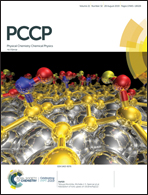Replica exchange MD simulations of two-dimensional water in graphene nanocapillaries: rhombic versus square structures, proton ordering, and phase transitions
Abstract
The hydrogen bond patterns, proton ordering, and phase transitions of monolayer ice in two-dimensional hydrophobic confinement are fundamentally different from those found for bulk ice. To investigate the behavior of quasi-2D ice, we perform molecular dynamics simulations of water confined between fixed graphene plates at a distance of 0.65 nm. While experimental results are still limited and theoretical investigations are often based on a single, often empirically based force field model, this work presents a systematic study modeling the water–graphene interaction by effective Lennard-Jones potentials previously derived from high-level ab initio CCSD(T) calculations of water adsorbed on graphene [Phys. Chem. Chem. Phys., 2013, 15, 4995]. For the water–water interaction different water force fields, i.e. SPCE, TIP3P, TIP4P, TIP4P/ICE, and TIP5P, are used. The water occupancy of the graphene capillary at a pressure of 1000 MPa is determined to be between 13.5 and 13.9 water molecules per square nanometer, depending on the choice of the water force field. Based on these densities, we explore the structure and dynamics of quasi-2D water for temperatures ranging from 200 K to about 600 K for each of the five force fields. To ensure complete sampling of the configurational space and to overcome the barriers separating metastable structures, these simulations are based on the replica exchange molecular dynamics technique. We report different tetragonal hydrogen bond patterns, which are classified as nearly square or as rhombic. While many of these arrangements are essentially flat, in some cases puckered arrangements are found, too. Also the proton ordering of the quasi-2D water structures is considered, allowing us to identify them as ferroelectric, ferrielectric or antiferroelectric. For temperatures between 200 K and 400 K we find several second-order phase transitions from one ice structure to another, changing in many cases both the arrangements of the oxygen atoms and the proton ordering. For temperatures between 400 K and 600 K there are melting-like transitions from a monolayer of ice to a monolayer of liquid water. These first-order phase transitions have a latent heat between 3.4 and 4.0 kJ mol−1. Both the values of the transition temperatures and of the latent heats display considerable model dependence for the five different water models investigated here.



 Please wait while we load your content...
Please wait while we load your content...